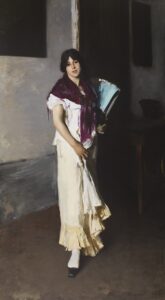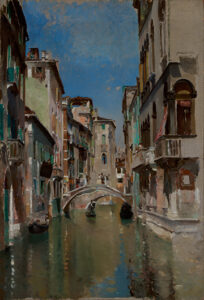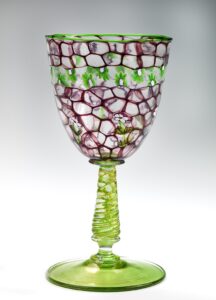Collins Gallery, Thompson Exhibition Building

Sargent, Whistler, and Venetian Glass: American Artists and the Magic of Murano, brings to life the Venetian glass revival of the late nineteenth century and the artistic experimentation the city inspired for visiting artists. It is the first comprehensive examination of American tourism, artmaking, and art collecting in Venice, revealing the glass furnaces and their new creative boom as a vibrant facet of the city’s allure.
Though the Venetian island of Murano has been a leading center of glass-making since the middle ages, today’s thriving industry stems from a burst in production between 1860 and 1915. In this era, Murano glassmakers began specializing in delicate and complex hand-blown vessels, dazzling the world with brilliant colors and virtuoso sculptural flourishes. This glass revival coincided with a surge in Venice’s popularity as a destination for tourists, leading to frequent depictions of Italian glassmakers and glass objects by artists from abroad. American painters and their patrons visited the glass furnaces, and many collected ornate goblets and vases decorated with flowers, dragons, and sea creatures. Venetian glass vessels, and also glass mosaics, quickly became more than souvenirs—these were esteemed as museum-quality works of fine art.
Moreover, the inventions of Murano’s master glassmakers established Venice as a center for artistic experimentation. Sojourns in Venice were turning points for John Singer Sargent, James McNeill Whistler, and scores of artists who followed in their footsteps, often referencing the glass industry in their works. Featuring more than 140 objects, this exhibition presents a choice selection of glass vessels in conversation with paintings, watercolors, and prints by the many talented American artists who found inspiration in Venice. This juxtaposition reveals the impact of Italian glass on American art, literature, design theory, and science education, as well as ideas at the time about gender, labor, and class relations. In addition to works by Sargent and Whistler, the exhibition features paintings and prints by Frank Duveneck, Thomas Moran, William Merritt Chase, Maurice Prendergast, Maxfield Parrish, Louise Cox, and Ellen Day Hale. These are featured alongside rarely seen Venetian glass mosaic portraits and glass cups, vases, and urns by the leading glassmakers of Murano, including members of the legendary Seguso, Barovier, and Moretti families. Remarkable works from the Smithsonian American Art Museum’s collection join loans from the Metropolitan Museum of Art, the Art Institute of Chicago, and dozens of other distinguished public and private collections.


For Sargent, Whistler, and many of their patrons, Venetian glassware was irresistibly beautiful, and collecting these exquisite vessels expressed respect for both history and innovation. By recreating their transatlantic journey—from the furnaces of Murano to American parlors and museums—this exhibition and catalogue will bring to life the creative energy that beckoned nineteenth-century tourists and artists to Venice. This spirit spawned the renowned Venice Biennale contemporary art festival, and it lives on in Venetian glassmakers’ continued commitment to excellence.
The exhibition is organized by Crawford Alexander Mann III, former curator of prints and drawings at the Smithsonian American Art Museum, current Chief Curator at Telfair Museums in Savannah, Georgia.
Sargent, Whistler, and Venetian Glass: American Artists and the Magic of Murano is organized by the Smithsonian American Art Museum. Generous support has been provided by The Gladys Krieble Delmas Foundation, Embassy of Italy in Washington DC, Chris G. Harris, the Raymond J. and Margaret Horowitz Endowment, Janet and William Ellery James, William R. Kenan Jr. Endowment Fund, Maureen and Gene Kim, The Lunder Foundation—Peter and Paula Lunder Family, Lucy S. Rhame, Holly and Nick Ruffin, the Smithsonian Scholarly Studies Awards, Rick and Lucille Spagnuolo, and Myra and Harold Weiss.
The accompanying catalogue is supported in part by Jane Joel Knox.
This exhibition is supported by an indemnity from the Federal Council on the Arts and the Humanities.
In-kind support has been provided by Christie’s.
75 Greenmanville Ave
Mystic, CT 06355
860-572-0711
info@mysticseaport.org
Copyright © 2021 Mystic Seaport Museum
75 Greenmanville Ave
Mystic, CT 06355
860-572-0711